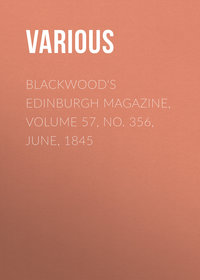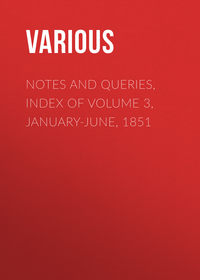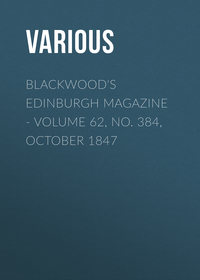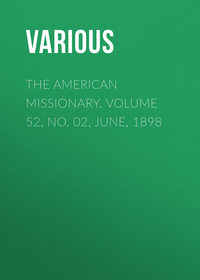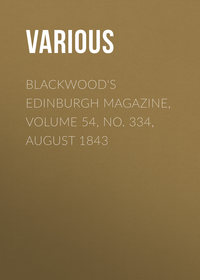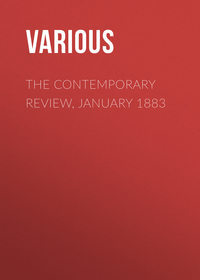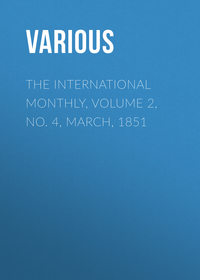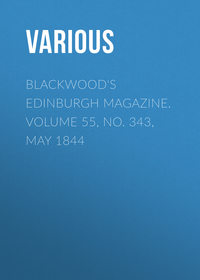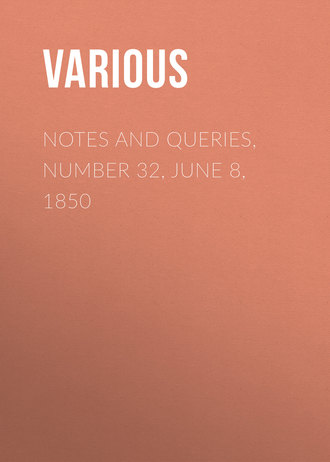 полная версия
полная версияNotes and Queries, Number 32, June 8, 1850
while one only reads "the temple." The question, therefore, is involved in the same doubt which I at first stated; for the subsequent lines quoted by P.H.F. prove nothing more than that the person described was a manciple in some place of legal resort, which was not disputed.
Edward Foss.Bawn (Vol. i., p. 440.).—If your Querist regarding a "Bawn" will look into Macnevin's Confiscation of Ulster (Duffy: Dublin, 1846, p. 171. &c.), he will find that a Bawn must have been a sort of court-yard, which might be used on emergency as a fortification for defence. They were constructed either of lime and stone, of stone and clay, or of sods, and twelve to fourteen feet high, and sometimes inclosing a dwelling-house, and with the addition of "flankers."
W.C. Trevelyan."Heigh ho! says Rowley" (Vol. i., p. 458.).—The burden of "Heigh ho! says Rowley" is certainly older than R.S.S. conjectures; I will not say how much, but it occurs in a jeu d'esprit of 1809, on the installation of Lord Grenville, as Chancellor, at Oxford, as will be shown by a stanza cited from memory:—
"Mr. Chinnery then, an M.A. of great parts, Sang the praises of Chancellor Grenville.Oh! he pleased all the ladies and tickled their hearts; But, then, we all know he's a Master of Arts, With his rowly powly, Gammon and spinach, Heigh ho! says Rowley."Chethamensis.Wimpole Street, May 11. 1850.
Arabic Numerals.—As your correspondent E.V. (Vol. i., p. 230.) is desirous of obtaining any instance of Arabic numerals of early occurrence, I would refer him, for one at least, to Notices of the Castle and Priory of Castleacre, by the Rev. J.H. Bloom: London; Richardson, 23. Cornhill, 1843. In this work it appears that by the acumen of Dr. Murray, Bishop of Rochester, the date 1084 was found impressed in the plaster of the wall of the priory in the following, form:—

The writer then goes on to show, that this was the regular order of the letters to one crossing himself after the Romish fashion.
E.S.T.Pusan (Vol. i., p. 440.)—May not the meaning be a collar in the form of a serpent? In the old Roman de Blanchardin is this line:—
"Cy guer pison tuit Apolin."
Can Iklynton again be the place where such an ornament was made? Ickleton, in Cambridgeshire, appears to have been of some note in former days, as, according to Lewis's Topog. Hist., a nunnery was founded there by Henry II., and a market together with a fair granted by Henry III. As it is only five miles from Linton, it may have formerly borne the name of Ick-linton.
C.I.R."I'd preach as though" (Vol. i., p. 415.).—The lines quoted by Henry Martyn are said by Dr. Jenkyn (Introduction to a little vol. of selections from Baxter—Nelson's Puritan Divines) to be Baxter's "own immortal lines." Dr. J. quotes them thus:—
"I preached as never sure to preach again,And as a dying man to dying men."Ed. S. Jackson.May 18.
"Fools rush in" (Vol. i., p. 348.).—The line in Pope,
"For fools rush in where angels fear to tread,"
it has been long ago pointed out, is founded upon that of Shakspeare,
"For wrens make wing where eagles dare not perch."
I know not why that line of Pope is in your correspondent's list. It is not a proverb.
C.B.Allusion in Friar Brackley's Sermon (Vol. i., p. 351.)—It seems vain to inquire who the persons were of whom stories were told in medieval books, as if they were really historical. See the Gesta Romanorum, for instance: or consider who the Greek king Aulix was, having dealings with the king of Syria, in the 7th Story of the Novelle Antiche. The passage in the sermon about a Greek king, seems plainly to be still part of the extract from the Liber Decalogorum, being in Latin. This book was perhaps the Dialogi decem, put into print at Cologne in 1472: Brunet.
C.B.Earwig (Vol. i., p. 383.).—This insect is very destructive to the petals of some kinds of delicate flowers. May it not have acquired the title of "couchbell" from its habit of couching or concealing itself for rest at night and security from small birds, of which it is a favourite food, in the pendent blossoms of bell-shaped flowers? This habit is often fatal to it in the gardens of cottagers, who entrap it by means of a lobster's claw suspended on an upright stick.
S.S.S.Earwig (Vol. i., p. 383.).—In the north of England the earwig is called twitchbell. I know not whether your correspondent is in error as to its being called in Scotland the "coach-bell." I cannot afford any explanation to either of these names.
G. Bouchier Richardson.Sir R. Haigh's Letter-book (Vol. i, p. 463.).—This is incorrect; no such person is known. The baronet intended is Sir Roger Bradshaigh, of Haigh; a very well-known person, whose funeral sermon was preached by Wroe, the warden of Manchester Collegiate Church, locally remembered as "silver-mouthed Wroe."
This name is correctly given in Puttick and Simpson's Catalogue of a Miscellaneous Sale on April 15, and it is to be hoped that Sir Roger's collection of letters, ranging from 1662 to 1676, may have fallen into the hands of the noble earl who represents him, the present proprietor of Haigh.
Chethamensis.Marescautia (Vol. i., p. 94.).—Your correspondent requests some information as to the meaning of the word "marescautia." Mareschaucie, in old French, means a stable. Pasquier (Recherches de la France, l. viii. ch. 2.) says,—
"Pausanias disoit que Mark apud Celtas signifioit un cheual … je vous diray qu'en ancien langage allemant Mark se prenoit pour un cheual."
In ch. 54. he refers to another etymolygy of "maréchal," from "maire," or "maistre," and "cheval," "comme si on les eust voulu dire maistre de la cheualerie." "Maréchal" still signifies "a farrier." Maréchaussée was the term applied down to the Revolution to the jurisdiction of Nosseigneurs les Maréchaux de France, whose orders were enforced by a company of horse that patrolled the highways, la chaussée, generally raised above the level of the surrounding country. Froissart applies the term to the Marshalsea prison in London. In D.S.'s first entry there may, perhaps, be some allusion to another meaning of the word, namely, that of "march, limit, boundary."
What the nature of the tenure per serjentiam marescautiæ may be I am not prepared to say. May it not have had some reference to the support of the royal stud?
J.B.D.Memoirs of an American Lady (Vol. i., p. 335.).—If this work cannot now be got it is a great pity,—it ought to go down to posterity; a more valuable or interesting account of a particular state of society now quite extinct, can hardly be found. Instead of saying that "it is the work of Mrs. Grant, the author of this and that," I should say of her other books that they were written by the author of the Memoirs of an American Lady. The character of the individual lady, her way of keeping house on a large scale, the state of the domestic slaves, threatened, as the only known punishment and most terrible to them, with being sold to Jamaica; the customs of the young men at Albany, their adventurous outset in life, their practice of robbing one another in joke (like a curious story at Venice, in the story-book called Il Peccarone, and having some connection with the stories of the Spartan and Circassian youth), with much of natural scenery, are told without pretension of style; but unluckily there is too much interspersed relating to the author herself, then quite young.
C.B.Poem by Sir E. Dyer (Vol. i., p. 355.).—"My mind to me," &c. Neither the births of Breton nor Sir Edward Dyer seem to be known; nor, consequently, how much older the one was than the other. Mr. S., I conclude, could not mean much older than Breton's tract, mentioned in Vol. i., p. 302. The poem is not in England's Helicon. The ballad, as in Percy, has four stanzas more than the present copy, and one stanza less. Some of the readings in Percy are better, that is, more probable than the new ones.
"I see how plenty surfeits oft."—P.suffers.—Var."I grudge not at another's gain".—P.pain.—Var."No worldly wave my mind can toss."—P.wants.—Var.These seem to me to be stupid mistranscriptions.
"I brook that is another's pain."—P."My state at one doth still remain."—Var.Probably altered on account of the slight obscurity; and possibly a different edition by the author himself.
"They beg, I give,They lack, I lend."—P. leave.—Var.In this verse,
"I fear no foe, I scorn no friend."—P. fawn.—Var.I think the new copy better.
"To none of these I yield as thrall,For why my mind despiseth all."—P. doth serve for.—Var.The var. much better.
In this—
"I never seek by bribes to please,Nor by dessert to give offence."—P. deceit.—Var.I cannot understand either.
So very beautiful and popular a song it would be well worth getting in the true version.
C.B.Monumental Brasses.—In reply to S.S.S. (Vol. i., p. 405.), I beg to inform him that the "small dog with a collar and bells" is a device of very common occurrence on brasses of the fifteenth and latter part of the fourteenth centuries. The Rev. C. Boutell's Monumental Brasses of England contains engravings of no less than twenty-three on which it is to be found; as well as two examples without the usual appendages of collar, &c. In addition to these, the same work contains etchings of the following brasses:—Gunby, Lincoln., two dogs with plain collars at the bottom of the lady's mantle, 1405. Dartmouth, Devon., 1403. Each of the ladies here depicted has two dogs with collars and bells at her feet.
The same peculiarities are exemplified on brasses at Harpham, York., 1420; and Spilsby, Lincoln., 1391. I will not further multiply instances, as my own collection of rubbings would enable me to do. I should, however, observe, that the hypothesis of S.S.S. (as to "these figures" being "the private mark of the artist") is untenable: since the twenty-three examples above alluded to are scattered over sixteen different counties, as distant from each other as Yorkshire and Sussex. Two examples are well known, in which the dog so represented was a favourite animal:—Deerhurst, Gloc., 1400, with the name, "Terri," inscribed; and Ingham, Norfolk, 1438, with the name "Jakke." This latter brass is now lost, but an impression is preserved in the British Museum. The customary explanation seems to me sufficient: that the dog was intended to symbolise the fidelity and attachment of the lady to her lord and master, as the lion at his feet represented his courage and noble qualities.
W. Sparrow Simpson.Queen's College, Cambridge, April 22. 1850.
Fenkle Street.—A street so called in Newcastle-upon-Tyne, lying in a part of the town formerly much occupied by garden ground, and in the immediate vicinity of the house of the Dominican Friars there. Also, a way or passage inside the town wall, and leading between that fortification and the house of the Carmelites or White Friars, was anciently called by the same name. The name of Fenkle or Finkle Street occurs in several old towns in the North, as Alnwick, Richmond, York, Kendal, &c. Fenol and finugl, as also finul, are Saxon words for fennel; which, it is very probable, has in some way or other given rise to this name. May not the monastic institutions have used fennel extensively in their culinary preparations, and thus planted it in so great quantities as to have induced the naming of localities therefrom? I remember a portion of the ramparts of the town used to be called Wormwood Hill, from a like circumstance. In Hawkesworth's Voyages, ii. 8., I find it stated that the town of Funchala, on the island of Madeira, derives its name from Funcko, the Portuguese name for fennel, which grows in great plenty upon the neighbouring rocks. The priory of Finchale (from Finkel), upon the Wear, probably has a similar origin; sed qu.
G. Bouchier Richardson.Newcastle-upon-Tyne, May 12. 1850.
Christian Captives (Vol. i., p. 441.)—In reply to your correspondent R.W.B., I find in the papers published by the Norfolk and Norwich Archæological Society, vol. i. p. 98., the following entries extracted from the Parish Registers of Great Dunham, Norfolk:—

Which sum was sent to Mr. Nicholas Browne, Registrar under Dr. Connant, Archdeacon of Norwich, Octr. 2d. 1680."
Probably similar entries will be found in other registers of the same date, as the collections appear to have been made by special mandate, and paid into the hands of the proper authorities.
E.S.T.Passage in Gibbon (Vol. i., p. 348.).—The passage in Gibbon I should have thought was well known to be taken from what Clarendon says of Hampden, and which Lord Nugent says in his preface to Hampden's Life had before been said of Cinna. Gibbon must either have meant to put inverted commas, or at least to have intended to take nobody in.
C.B.Borrowed Thoughts (Vol. i., p. 482.)—La fameuse La Galisse is an error. The French pleasantly records the exploits of the celebrated Monsieur de la Galisse. Many of Goldsmith's lighter poems are borrowed from the French.
C.Sapcote Motto (Vol. i., pp. 366. and 476.).—Taking for granted that solutions of the "Sapcote Motto" are scarce, I send you what seems to me something nearer the truth than the arbitrary and unsatisfactory translation of T.C. (Vol. i, p. 476.).
The motto stands thus:—
"sco toot × vinic [or umic] × poncs."Adopting T.C.'s suggestion that the initial and final s are mere flourishes (though that makes little difference), and also his supposition that c may have been used for s, and as I fancy, not unreasonably conjecturing that the × is intended for dis, which is something like the pronunciation of the numeral X, we may then take the entire motto, without garbling it, and have sounds representing que toute disunis dispenses; which, grammatically and orthographically corrected, would read literally "all disunions cost," or "destroy," the equivalent of our "Union is strength." The motto, with the arms, three dove-cotes, is admirably suggestive of family union.
W.C.Lines attributed to Lord Palmerston (Vol. i., p. 382.).—These lines have also been attributed to Mason.
S.S.S.Shipster (Vol. i., p. 339.).—That "ster" is a feminine termination is the notion of Tyrwhitt in a note upon Hoppesteris in a passage of Chaucer (Knight's Tale, l. 2019.); but to ignorant persons it seems not very probable. "Maltster," surely, is not feminine, still less "whipster;" "dempster," Scotch, is a judge. Sempstress has another termination on purpose to make it feminine.
I wish we had a dictionary, like that of Hoogeven for Greek, arranging words according to their terminations.
C.B.Miscellanies
Blue Boar Inn, Holborn.—The reviewer in the last "Quarterly" of Mr. Cunningham's Handbook for London, makes an error in reference to the extract from Morrice's Life of Lord Orrery, given by Mr. Cunningham under the head of "Blue Boar Inn, Holborn," and transcribed by the reviewer (Qu. Rev. vol. lxxxvi., p. 474.). Morrice, Lord Orrery's biographer, relates a story which he says Lord Orrery had told him, that he had been told by Cromwell and Ireton of their intercepting a letter from Charles I. to his wife, which was sewn up in the skirt of a saddle. The story may or may not be true; this authority for it is not first-rate. The Quarterly reviewer, in transcribing from Mr. Cunningham's book the passage in Morrice's Life of Lord Orrery, introduces it by saying,—"Cromwell, in a letter to Lord Broghill, narrates circumstantially how he and Ireton intercept, &c." This is a mistake; there is no letter from Cromwell to Lord Broghill on the subject. (Lord Broghill was Earl of Orrery after the Restoration.) Such a letter would be excellent authority for the story. The mistake, which is the Quarterly reviewer's, and not Mr. Cunningham's, is of some importance.
C.H.Lady Morgan and Curry.—An anecdote in the last number of the Quarterly Review, p. 477., "this is the first set down you have given me to-day," reminds me of an incident in Dublin society some quarter of a century ago or more. The good-humoured and accomplished—Curry (shame to me to have forgotten his christened name for the moment!) had been engaged in a contest of wit with Lady Morgan and another female célébrité, in which Curry had rather the worst of it. It was the fashion then for ladies to wear very short sleeves; and Lady Morgan, albeit not a young woman, with true provincial exaggeration, wore none, a mere strap over her shoulders. Curry was walking away from her little coterie, when she called out, "Ah! come back Mr. Curry, and acknowledge that you are fairly beaten." "At any rate," said he, turning round, "I have this consolation, you can't laugh at me in your sleeve!"
Scotus.Sir Walter Scott and Erasmus.—Has it yet been noticed that the picture of German manners in the middle ages given by Sir W. Scott, in his Anne of Geierstein (chap. xix.), is taken (in some parts almost verbally) from Erasmus' dialogue, Diversoria? Although Sir Walter mentions Erasmus at the beginning of the chapter, he is totally silent as to any hints he may have got from him; neither do the notes to my copy of his works at all allude to this circumstance.
W.G.S.Parallel Passages.—A correspondent in Vol. i., p. 330, quoted some parallels to a passage in Shakspeare's Julius Cæsar. Will you allow me to add another, I think even more striking than those he cited. The full passage in Shakspeare is,
"There is a tide in the affairs of man,Which taken at the flood leads on to fortune.Omitted, all the voyage of their livesIs bound in shallows and in miseries."In Bacon's Advancement of Learning, book 2, occurs the following:—
"In the third place, I set down reputation because of the peremptory tides and currents it hath, which, if they be not taken in due time, are seldom recovered, it being extreme hard to play an after game of reputation."
E.L.N.Gray's Ode.—In return for the information about Gray's Ode, I send an entertaining and very characteristic circumstance told in Mrs. Bigg's (anonymous) Residence in France (edited by Gifford):—
"She had a copy of Gray when she was arrested in the Reign of Terror. The Jacobins who searched her goods lighted on the line—
'Oh, tu severi religio loci,'and said, 'Apparemment ce livre est quelque chose de fanatique.'"
My informant tells me that the monk he saw was the same as the one mentioned by your correspondent, and that he had a motto from Lord Bacon over his cell.
C.B.The Grand Style.—Is it not extremely probable that Bonaparte plagiarised the idea of the centuries observing the French army from the pyramids from these lines of Lucan?—
"Sæcula Romanos nunquam tacitura labore, Attendunt, oevumque sequens speculatur ab omni Orbe ratem."—Phars. viii. 622.
One of the recent French revolutionists (I think Rollin) compared himself with the victim of Calvary. Even this profane rant is a plagiarism. Gracchus Baboeuf, who headed the extreme republican party against the Directory, exclaimed, on his trial, that his wife, and those of his fellow-conspirators, "should accompany them even to Calvary, because the cause of their punishment should not bring them to shame."—Mignet's French Revolution, chap. xii.
J.F. Boyes.Hoppesteris.—The "shippis hoppesteris," in Chaucer's Knight's Tale, 2019., is explained by Tyrwhitt to mean dancing, and that in the feminine—a very odd epithet. He tells us that the corresponding epithet in Boccaccio is bellatrici. I have no doubt that Chaucer mistook it for ballatrici.
C.B.Sheridan's Last Residence (Vol. i., p. 484.).—I wonder at any doubt about poor Sheridan's having died in his own house, 17. Saville Row. His remains, indeed, were removed (I believe for prudential reasons which I need not specify) to Mr. Peter Moore's, in Great George Street; but he was never more than a temporary, though frequent visitor at Mr. Moore's.
C.Miscellaneous
NOTES ON BOOKS, CATALOGUES, SALES, ETC
The Devices and Mottoes of the later Middle Ages (Die Devisen und Motto des Späteren Mittelalters, von J.V. Radowitz), just imported by Messrs. Williams and Norgate, is one of those little volumes which such of our readers as are interested in the subject to which it relates should make a note of. They will, in addition to many novel instances of Devices, Mottoes, Emblems, &c., find much curious learning upon the subjects, and many useful bibliographical references.
Messrs. Sotheby and Wilkinson still sell, on Saturday next, the very beautiful collection of Oriental Manuscripts of the late Dr. Scott; on Monday and Tuesday, his Medical Library; on Wednesday, his valuable Collection of Music; and on Thursday, his Philosophical and Mathematical Instruments, Fire-arms, and other miscellaneous objects of interest.
We have received the following catalogues:—John Petheram's (94. High Holborn) Catalogue, Part CXII., No. 6. for 1850 of Old and New Books; W.S. Lincoln's (Cheltenham House, Westminster Road) Fifty-Seventh Catalogue of Cheap Second-hand Books, English and Foreign; James Sage's (4. Newman's Row, Lincoln's Inn Fields) Miscellaneous List of Valuable and Interesting Books; Edward Stibbs' (331. Strand) Catalogue of Miscellaneous Collection of Books, comprising Voyages, Travels, Biography, History, Poetry, Drama, &c.
Notices to Correspondents
Index and Title-Page to Volume the First. The Index is preparing as rapidly as can be, consistently with fullness and accuracy, and we hope to have that and the Title page ready by the 15th of the Month.
Covers for the First Volume are preparing, and will be ready for Subscribers with the Title-Page and Index.
NEW WORKS IN GENERAL LITERATURE
MEMOIRS OF THE DUKES OF URBINO (1440 to 1630). By JAMES DENNISTOUN, of Dennistoun. With numerous Portraits, Plates, Facsimiles, and Woodcuts. 3 vols. square crown 8vo. 2l. 8s.
IISIR ROGER DE COVERLEY. From "The Spectator". With Notes, &c., by W.H. WILLIS and Twelve fine Woodcuts from drawings by F. TAYLER. Crown 8vo. 15s.; morocco, 27s.
IIIMrs. JAMESON'S SACRED and LEGENDARY ART or, LEGENDS of the SAINTS and MARTYRS. New Edition, complete in One Volume with Etchings by the Author, and Woodcuts. Square crown 8vo. 28s.
IVMrs. JAMESON'S LEGENDS OF THE SAINTS AND MARTYRS, as represented in the Fine Arts. With Etchings by the Author, and Woodcuts. Square crown 8vo. 28s.
VTHE CHURCH IN THE CATACOMBS: a Description of the Primitive Church of Rome. BY CHARLES MAITLAND. New Edition, with Woodcuts. 8vo. 14s.
VIMr. MACAULAY'S HISTORY OF ENGLAND, from the Accession of James II. New Edition. Vols. I. and II. 8vo. 32s.
VIIJOHN COAD'S MEMORANDUM of the SUFFERINGS of the REBELS sentenced to Transportation by Judge Jeffreys. Square fcap. 8vo. 4s. 6d.




